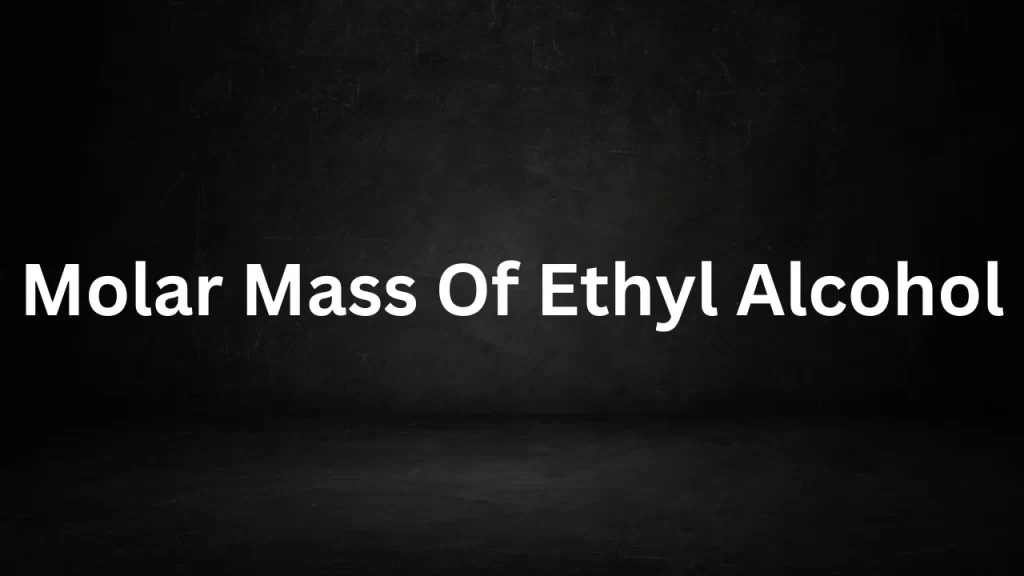Tag: 100 ethanol
Molar Mass Of Ethyl Alcohol
Molar Mass Of Ethyl Alcohol: The molar mass of ethyl alcohol, also known as ethanol, is a critical concept in chemistry.
Ethanol is a highly utilized and extensively studied organic compound, with diverse applications spanning beverages, industrial processes, fuels, and pharmaceuticals. This article will explore the molar mass of ethyl alcohol, its calculation, its importance across different domains, and its real-world uses.

Molar Mass Of Ethyl Alcohol
Defining Molar Mass
Molar mass refers to the mass of one mole of a particular substance, expressed in grams per mole (g/mol). In the case of ethyl alcohol (C2H5OH), its mol mass represents the combined mass of two moles of carbon (C) atoms, six moles of hydrogen (H) atoms, and one mole of oxygen (O) atom.
Calculating the Molar Mass
To calculate the mol mass of ethyl alcohol (C2H5OH), we sum the atomic masses of its constituent elements:
- Carbon (C): Atomic mass ≈ 12.01 g/mol
- Hydrogen (H): Atomic mass ≈ 1.01 g/mol
- Oxygen (O): Atomic mass ≈ 16.00 g/mol
Now, let’s calculate the molar mass of C2H5OH:
Molar Mass of C2H5OH = (2 × Molar Mass of C) + (6 × Molar Mass of H) + Molar Mass of O Molar Mass of C2H5OH = (2 × 12.01 g/mol) + (6 × 1.01 g/mol) + 16.00 g/mol Molar Mass of C2H5OH ≈ 6.07 g/mol
Therefore, the molar mass of ethyl alcohol (C2H5OH) is approximately 46.07 grams per mole.
Significance in Chemistry
- Stoichiometry: Ethyl alcohol’s molar mass is crucial in stoichiometry, which involves calculating the quantities of reactants and products in chemical reactions involving ethanol.
- Gas Laws: It is vital in the study of gases, where ethanol is often used as a reference substance to relate properties such as pressure, volume, temperature, and mass.
- Alcohol Content: In the beverage industry, understanding the molar mass of ethyl alcohol is essential for calculating the alcohol content in alcoholic beverages.
Real-World Applications
- Beverage Production: The mol mass of ethyl alcohol is used to determine the alcohol content in spirits, wines, and beers.
- Fuel Industry: Ethanol is a common biofuel, and its molar mass is significant in the production and energy calculations of bioethanol.
- Pharmaceutical Industry: Ethanol is used in pharmaceutical formulations, and its molar mass plays a role in dosage calculations and drug formulations.
- Chemical Processes: Ethanol finds use in a variety of industrial processes, with its molar mass being crucial for precise measurements and reactions.
Conclusion
The mol mass of ethyl alcohol (C2H5OH), approximately 46.07 g/mol, is a fundamental concept in chemistry with wide-ranging implications. It is indispensable in stoichiometry, gas law applications, alcohol content determination, and various real-world industries such as beverage production, fuel, pharmaceuticals, and chemical processes. Ethanol’s significance extends beyond the laboratory, making it a vital compound in both scientific research and practical applications across diverse fields. Understanding the mol mass of ethyl alcohol is not only a foundational concept in chemistry but also a key factor in addressing various societal and industrial needs.
Read More
- Molecular Mass Of Calcium Carbonate
- Molar Mass Of Carbon Dioxide
- Difference Between Force And Momentum
- Law Of Conservation Of Linear Momentum
- Molecular Weight Of MgSO4
Frequently Asked Questions (FAQs) On Molar Mass Of Ethyl Alcohol
1. What is the molar mass of ethyl alcohol (C2H5OH)?
The mol mass of ethyl alcohol, also known as ethanol (C2H5OH), is approximately 46.07 grams per mole (g/mol).
2. How does the molar mass of ethyl alcohol relate to gas laws?
In gas studies, ethanol’s molar mass is applied in gas laws, linking properties such as pressure, volume, temperature, and mass. Ethanol frequently serves as a reference substance in gas law applications.
3. What is the atomic mass of carbon (C)?
The atomic mass of carbon is approximately 12.01 g/mol.
4. What is the atomic mass of hydrogen (H)?
The atomic mass of hydrogen is approximately 1.01 g/mol.
5. What is the atomic mass of oxygen (O)?
The atomic mass of oxygen is approximately 16.00 g/mol.